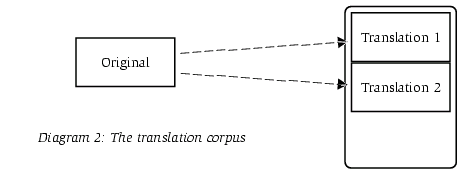|
Current Events | Write to us | TELRI Main Page | TELRI Seminar |
Analysing the Fluency of Translators
Rafal Uzar, Jacek Walinski
University of Lodz
Lodz, Poland
The PELCRA project has targeted several interest areas which it has been slowly working on from the inception of the project several years ago. One of our primary goals is to collect and process a ’large’ corpus of natural Polish in the hope of constructing a Polish National Corpus for use primarily in contrastive studies together with the BNC and other national corpora (CNC etc.). The second - more fruitful - corpus project to stem from PELCRA is the "learner English" corpus described more fully in: Botley, S. & Uzar, R. (1998a, 1998b); Lenko, A. (1999); Lenko, A., B. Lewandowska-Tomaszczyk & A. McEnery (1999); Mason, O. & R. Uzar (1999); Uzar, R. (1997). The last piece in the PELCRA jigsaw is the translation element. In conjunction with PhD research into fluency, we have decided to combine work in the analysis of fluency in learner English with the appropriacy and quality of translations produced by our students at the Lódz University’s department of English.
The first - and ongoing - problem that we have found within the bounds of our PhD work is determining a working definition of fluency. What is it? How can we quantify it? How can we test it? How can we be sure this is a good gauge? Generally speaking, it is easy to pinpoint a learner’s intonation or grammar, adequacy or appropriacy but once we hit the term fluency heads begin to shake and students of English tend to get lost. Everybody knows what fluency means but defining this precisely and explaining to a learner what is required of him or her is a little (!) more difficult. All native speakers know what fluency feels like, what it looks like and how it sounds but very few can explain it. Fluency (if not the same as) has much in common with the elusive native speaker competence which, as we all know, is more often talked about or around rather than described. Performance is of course easier to quantify and therefore this is where we have begun.
In order to define fluency, a short pilot questionnaire was given to subjects directly involved with EFL, for example professional translators, English school teachers, departmental lecturers, English language students from both the department and private language schools in order to get a feel for how the word ‘fluency’ is interpreted. In total, 25 questionnaires were collected. We discuss the results below and our more complex ideas concerning the definition of this term.
Our next order of business was to give around ninety students a short text to translate from Polish into English (i.e. from native into non-native). This broke down to 45 students from the 3rd year of their MA programme and 45 from the 4th year, the 1st and 2nd years of a three-year translation module, respectively. These texts were then put together to form a small translation corpus.

As can be seen from the diagram above, the corpus contained all ninety variant translations. This allowed us to compare not only the original with each individual translation or each translation with another translation but we could compare individual translations with the entire wordlist and grammatical range of the corpus and see how far each individual text strayed from the corpus median.
We focused on lexical and grammatical hotspots which we found after analysing these translated texts and then set up a system of fluency "scores" for each of these hotspots and in that way introduced a quantifiable method of analysing fluency.
Back to Newsletter no. 9.